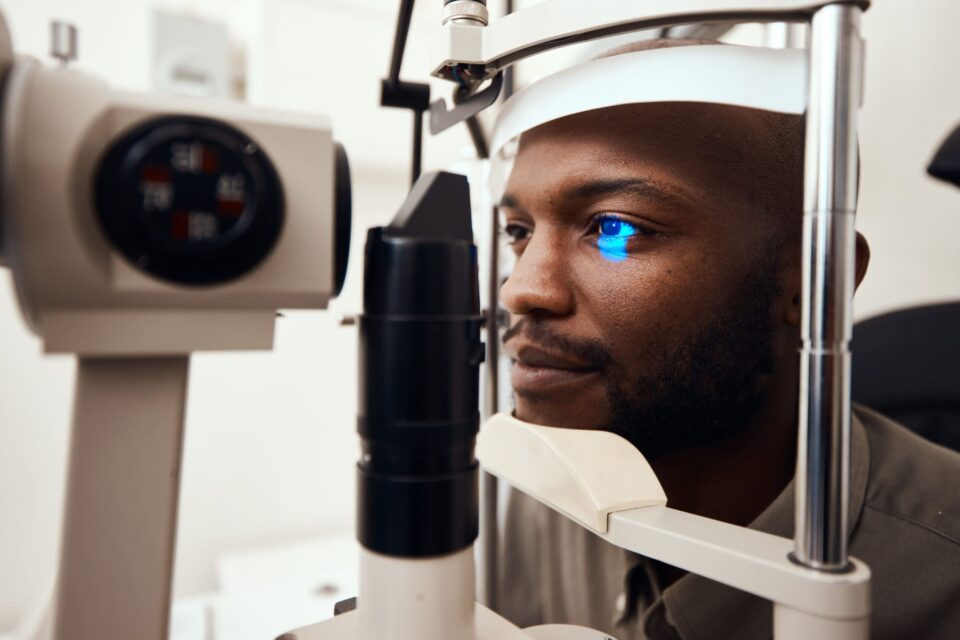
Procedures
Monovision
Home / Procedures /
What is Monovision?
Monovision is a vision correction method designed to help people who have trouble seeing clearly at both near and far distances by correcting for near vision in one eye and far vision in the other. Correcting for two distances is why monovision is also referred to as “blended vision”. Monovision is a versatile approach that works with contacts as well as many vision-correction procedures, such as LASIK, cataract surgery, and RLE. In fact, doctors will recommend patients try contacts prior to undergoing a monovision procedure.
How does Monovision Work?
Monovision allows individuals to see well at both near and far distances by correcting one eye for near vision and one eye for distant vision. Eye dominance typically determines which eye to use for distance or near, with the distance-correcting lens used with the dominant eye. The key to success with monovision lies in the brain’s ability to adapt, or “blend”, to the different focal points provided by each eye.

Blended Vision (Monovision) for Presbyopia
Presbyopia is a type of refractive error where the eye undergoes a gradual loss of the ability to focus on near objects as a result of age-related changes in the eye. The mechanism which allows the eye to focus on a far object that becomes intermittently closer is called accommodation, and because of changes that happen naturally in the eye over time, loss of accommodation is a natural change that becomes more apparent as people enter their 40’s and 50’s.
There are multiple physiological functions in and around the eye that, together, allow for accommodation. One of these is the eye’s natural lens, and replacing the natural lens with an artificial one is one of the primary ways doctors help patients regain as much accommodation as possible.
Symptoms of presbyopia include the need to hold reading material farther away to see more clearly, eyestrain or headaches when performing close-up tasks for an extended period, and/or difficulty seeing in dim or low-light conditions when focusing on near objects.
Non-Invasive Solutions for Presbyopia
Presbyopia and Glasses
People who have lost their accommodation, but still have good distance vision, may only require glasses for reading. In contrast, people with presbyopia in combination with other types of refractive errors may require other or additional types of glasses. Common refractive errors are: myopia (difficulty seeing far distances), hyperopia (more blur at near than at distance) and astigmatism (blur or distorted vision at all distances).
People with myopia who have lost their accommodation may be able to see close-up objects by simply removing their distance glasses. However, people that want to leave their eyeglasses on all the time (even people with myopia) will need multifocal eyeglasses, which allow for focusing at various distances. Bifocal eyeglasses have two prescriptions (distance and near). Trifocal eyeglasses have three prescriptions (distance, intermediate, and near). Progressive (no line multifocal) eyeglasses have a progressive change of focus from distance to near.
Monovision Contacts
There are other options besides wearing eyeglasses for patients dealing with presbyopia. Many people wear contact lenses. As with eyeglasses, patients can wear contact lenses (for distance correction) or multifocal contact lenses. However, some contact lens wearers do not like the disadvantages of having to wear reading glasses or multifocal contact lenses- Multifocal contact lenses can potentially create blur and glare at all distances. They also tend to be more expensive than single focus contact lenses. As a compromise, some people choose the monovision or blended vision approach with single-focus contact lenses.
The contact lens used to provide good distance vision is typically put on your dominant eye and the contact lens used to provide good near vision is typically put on the non-dominant eye.
The beauty of contact lenses is that patients can try monovision out first before committing to this. If the patient is not seeing clearly or is uncomfortable, the eye doctor can try putting the distance corrected contact lens on the non-dominant eye and the near corrected lens on the dominant eye to determine if this is clearer and more comfortable for the patient.
Modified Monovision Contacts
There is also a technique which combines monovision and multifocal lenses called “modified monovision”. An eye care professional can fit you with a multifocal contact lens in both eyes. If near vision is still not clear even with the maximum near power available (near powers often come in low medium and high near powers, called “add”), one eye can be made clearer for near vision. The eye that is made clearer for near (usually the non-dominant eye) will be more blurred for distance vision.
Client Testimonial
“Since my surgery, I am still noticing little things that come up when I say, "Oh isn't that nice!"”
Preparing for Monovision Surgery
Patients interested in monovision LASIK, RLE or Cataract Surgery can try it out with contact lenses before committing to this approach. The eye doctor will test both combinations for which contact is in which eye to adjust to what is most comfortable. If the patient has prior experience with monovision lenses, this is a strong sign that they will do well using monovision LASIK or doing monovision with IOLs.
Monovision LASIK
LASIK, or Laser-Assisted in Situ Keratomileusis, is a transformative, minimally invasive procedure designed to reshape the cornea (the clear, front part of your eye) to correct common vision problems such as myopia, hyperopia, and astigmatism.
One thing LASIK cannot normally correct is presbyopia. Presbyopia is the result of your natural lens in the eye losing its ability to focus on near objects.
Since LASIK is performed on a different part of the eye (the cornea), only distance vision can be corrected without sacrificing near vision. So, people that have LASIK often end up having to wear reading glasses when they reach their 40’s and 50’s. An alternative to having to wear reading glasses is asking your eye doctor to try monovision LASIK surgery.
Monovision Cataract Surgery
Cataract surgery is another type of eye surgery that can correct refractive errors on top of cataracts. A cataract develops when the natural, clear lens of the eye becomes cloudy. When the cloudiness of the lens becomes significant, vision is impaired. An eye surgeon removes the natural, cloudy lens and inserts an artificial, clear lens containing a prescription to allow clear viewing. These artificial, clear lenses are called “intraocular lens implants” or “IOLs”.
Monofocal IOLs for Cataract Surgery
Monofocal IOLs are used to provide clear vision at one focal point after the eye’s natural lens is removed. IOLs are used to replace the natural lens after the natural lens has developed into a cataract. This type of lens will focus for one distance only: either distance, near or intermediate.
When patients choose a monofocal IOL, most patients choose to be corrected for distance. In this case, eyeglasses will be required to correct for clear, near vision. Patients who want a broader range of distance can choose to implement blended vision (monovision) with IOLs.
For those patients who desire to see at all distances, these patients may choose multifocal IOLs, which are capable of providing focus for a multitude of different distance ranges.
Blended Vision for Cataract Surgery
Monovision cataract surgery works by selecting one monofocal IOL for distance in one eye, and near correction for the other eye. This may allow them to see both far away and up close. The disadvantage is that one eye sees clearly at a distance, while the other eye will be blurred at a distance (since it’s targeted for near vision).
Monovision RLE
The clear vision offered by IOLs also appeals to people with refractive errors, but without visually significant cataracts. Eye surgeons now offer this type of surgery for people who want to see clearly without glasses but do not qualify for cataract surgery.
This procedure is known as refractive lens exchange or (RLE surgery) and is a great alternative to LASIK. As with cataract surgery, monovision can be used for RLE surgery to provide a broad range of clear vision.
Costs of Monovision Procedures
Monovision procedures involving lenses (contact or IOLs) can be less expensive than the alternative approach that uses multifocals for vision correction. Depending on the type of procedure, the lens might even be covered by your insurance plan.
It is always recommended to ask your provider what out of pocket expenses are involved in your monovision procedure and to check what’s covered by insurance so you can make an informed choice.
Is Monovision a Good Idea?
Monovision is a compromise. All monovision procedures (LASIK, contact lenses, cataract surgery and RLE) have advantages and disadvantages.
Monovision Advantages
- The main advantage of monovision is that a broad range of vision can be achieved by correcting one eye for near vision and another distance. Monovision with contact lenses can be used as a trial run for permanent monovision procedures, so you can test if this approach is right for you.
- There is also a cost factor associated with the price of lenses. Multifocal lenses (both contact lenses and IOLs) tend to be more expensive. Monovision with single-focus lenses allow patients to potentially be free of eyeglasses without the added costs involved with multifocal lenses.
- Monovision with single focus lenses can also be a suitable alternative for patients who want the broader range of vision without risking side effects associated with multifocal lenses (like nighttime glare and halos).
Monovision Disadvantages
- The main disadvantage of monovision is that one eye sees clearly at a distance, while the other eye will be blurred at a distance (since it’s targeted for near vision). Another disadvantage of monovision lenses is that only distance and near vision is corrected. Intermediate range (such as the computer monitor, which is often at arm’s length away) may be blurred. Unfortunately, we do not have a third eye to take care of this intermediate range.
- It is possible to have the near vision corrected eye altered to see more clearly at intermediate ranges, but then very close objects will be more blurred.
Want to get rid of reading glasses?
Monovision can correct for presbyopia and restore your ability to focus on near objects. Find the right monovision proedure for your eye health needs at NVISION.

Take the Next Step to Clear Vision Today
For over 25 years, NVISION has been the trusted choice in custom vision correction. With 135+ locations nationwide and over 2.5 million procedures performed, our board-certified surgeons combine expertise with the latest technology to deliver exceptional care.
Your journey to better vision starts here.

Book Your Consultation
You're one step closer to life without glasses or contacts. Just answer a few quick questions about your eye exam, and we'll lock in your appointment.
Have a question? Give our experts a call!
877-455-9942